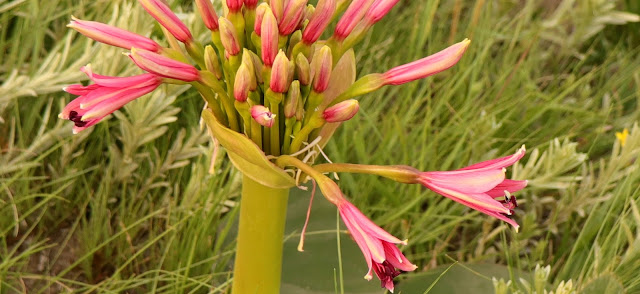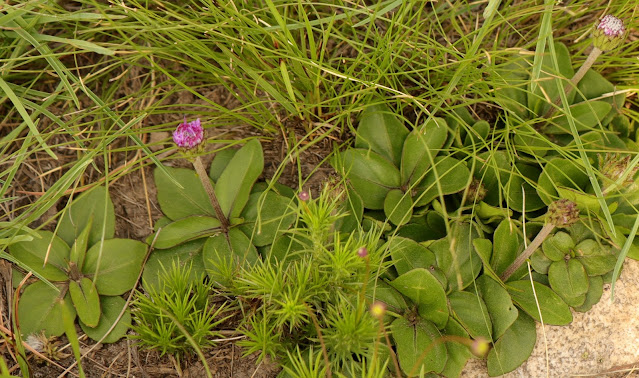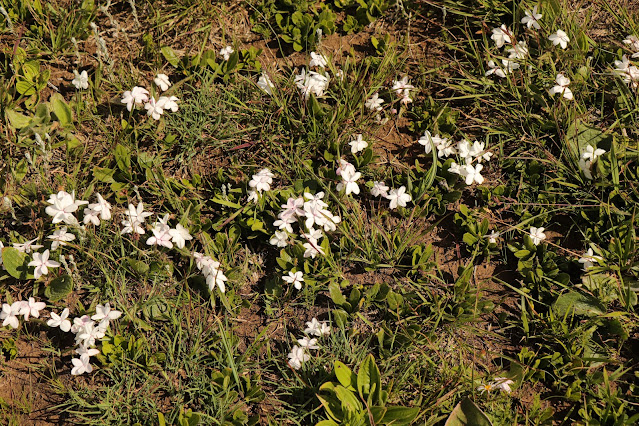Barefoot into the sunset
Plant walks around Dumbe Farm and the Kaalvoet Vrou Monument, November 2023
by Sandra Falanga
 |
| Brunsvigia radulosa |
At the end
of last year, we had an extended holiday in the Drakensberg and spent a few
days on Dumbe Farm. Dumbe is on the Free State - KwaZulu-Natal border between
Harrismith and Bergville, near Sterkfontein Dam and the top of Oliviershoek
Pass. The farm has historical links with the Great Trek. The Kaalvoet Vrou
(barefoot lady) Monument and the track of the first Voortrekker ox wagon descent
down the Drakensberg are on the farm. After
a quick stop at the monument and Kerkenberg during 2021, there was a persistent
niggle to return for a longer stay. The farm is quiet and the views expansive.
The monument and accommodation are perched on the escarpment.
 |
Views from Dumbe towards KwaZulu-Natal
and the Drakensberg’s Amphitheatre. |
I fell
boots and all for the majesty of the Drakensberg and its plants when we lived
for a short while (too short!) in the nearby Free State town of Harrismith. That
was more than two decades ago, but plant-wise the northern berg and
north-eastern Free State is an important focus area for me and I’m still quite driven
to meet and greet all its plants.
The PlantLife
editor noticed my uploads of the Dumbe plants to iNaturalist and suggested a
contribution to PlantLife. I’ll share plants that stood out to me, were new to
me, were favourites, were prevalent, some daisy conundrums - and those I took
half decent photographs of. To see what has been recorded on iNaturalist for
the farm and surrounding area, follow this link: PlantSpecies_near_Dumbe.
 |
| Koppies can be so tempting. |
Apart from the iconic Free
State koppie that just had to be scaled, our walks were mostly along the
escarpment. The grassland was short and sparse with cattle present and the
terrain was rocky, with rocky ridges and a fair amount of flat, exposed rock
sheets. From the trail, one looked down onto the numerous small patches of
forest below the escarpment and that clad the little kloofs and drainage lines.
The grey-green foliage of the yellowwoods, Podocarpus latifolius, was
quite noticeable and were the easiest trees in the forest canopy to name.
 |
| The escarpment with one of the trails running along it. The forest below shows the prominent grey-green colour of the yellowwoods. The 4x4 track of Retief’s Pass skirts the slope a bit further down. |
The
monument of the barefoot lady is in a small fenced-off camp, open to the
public. The statue is on a berm-like rocky ridge. Typical of grasslands, many plants
were tucked into the nooks and crannies and several species were new to me.
 |
Rotheca hirsuta f. triphylla.
This Rotheca with its club-shaped buds and unusual colour stopped me in my
tracks. I found it below the statue. |
 |
| Bridsonia chamaedendrum, a new plant for me. Peeking out on the right are the interesting leaves of Alepidea natalensis. This was in flower along rock ledges. |
 |
| Hypoxis hirsuta |
 |
Pseudopegolettia thodei, this and the Hypoxis above were both found at the monument site. |
 |
| Gladiolus longicollis |
 |
Afroaster perfoliatus were quite prevalent. |
 |
Spunky Cyanotis
speciosa. I enjoyed the common names listed for it on iNaturalist. Showy
Blue Ear, Doll’s Powderpuff and Bloupoeierkwassie. |
 |
Pearsonia grandifolia. Another new one for me, seen occasionally. |
 |
Lasiosiphon kraussianus. Cheerful sunbursts of
colour were irresistible. |
 |
Both Helichrysum acutatum and H. oreophilum were in
flower. From a distance they look pretty much the same. This is a typical
example of a Drakensberg daisy identification conundrum! |
 |
Berkheya
setifera. Few
things brighten up a day like the spikey cheerfulness of a yellow Berkheya in
flower. |
 |
| Metalasia densa bushes at Kerkenberg, 2021 |
 |
Iconic landscape of the northeastern Free State. Kerkenberg is to the
west of the farm. The Retief Klip site is worth a visit, but the road there is
terrible. |
As for
woody species, the usual, expected cohort was encountered. Many prefer bush
clumps to open grassland, benefitting from their association with large
boulders, which serve as hot water bottles, fire refugia and no doubt its own
microclimate and moisture regime. Regulars noted were: Leucosidea sericea
(Ouhout), Halleria lucida (Notsung, Tree fuchsia), Buddleja
salviifolia, Rhamnus prinoides (Blinkblaar), occasional Cussonia
spicata (Kiepersol),Greyia sutherlandii (Natal bottlebrush) and Rhoicissus
tridentata.
 |
| Rhoicissus tridentata (left),
a shrubby creeper
often in bush clumps in the northern Drakenberg. Searsia
discolor (right) is
comfortable amongst the grasses. |
 |
| The Silver-leaved Protea, Protea roupelliae subsp. roupelliae |
Open
grassland is not an issue for Protea roupelliae subsp. roupelliae. These
silvery trees occur in social stands, though spaced apart. They were in flower
and from the vantage point of our accommodation on the slope above the trees,
we were in for a treat: a constant sugar rush show by the Malachite Sunbird
(Jangroentjie) and Gurney’s Sugarbird! The interspecies interactions between
the two birds and the mutual reliance of the Protea and the birds were both
revealing and hugely entertaining. I could watch the beautiful and confident
Gurney’s Sugarbird’s posturing for hours. I think it was fully aware of us and
made its point: I am local royalty. And we understood that the very active flitting
about with loud frrrt frrrt frrrt wing sounds, always perching on the highest
spot and the casting of haughty glances – was exactly that!
 |
| Gurney's Sugarbird |
 |
| Malachite Sunbird |
Achieving
tree status along the escarpment seemed particularly tough for Protea caffra
subsp. caffra. Plants were at best knee-high, with a sturdy above-ground
rootstock visible. The odd straggly sorry-looking treelets on more sheltered
slopes are unlikely to pass auditions for Tolkienesque novels.
 |
| A meadow filled choc-a-block with grassland pretties and a bit of the 4x4 track, Retief's Pass, can be seen. |
During our stay we would see or hear the red tractor rumble up or down the old Voortrekker pass below our accommodation. The route as the first descent down into KwaZulu-Natal by the Retief party of Voortrekkers and their ox wagons in 1837. We didn’t get to hike the track but I had a royal time sitting in the grass near the start of the track. Surrounded by Pelargonium luridum, Acalypha species, Helichrysum aureonitens, a forest patch a catspit away (this is a translation from the Afrikaans term “katspoegie”, in this case meaning “just a short distance away” - Ed.), and photographing a girly pink Brunsvigia radulosa (which very nicely matched my luminous pink flips-flops, I just couldn’t be happier!
FAVOURITE RESOURCES & REFERENCES
Hilliard,
O.M. 1977. Compositae in Natal. University of Natal Press.
Pooley,
Elsa. 1998. A Field Guide to the Wild Flowers of KwaZulu-Natal and the Eastern
Region. Natal Flora Publications Trust.
Pooley,
Elsa. Mountain Flowers. 2003. A Field Guide to the Flora of the Drakensberg and
Lesotho. The Flora Publications Trust.
iNaturalist Link to Plants Species of Dumbe & Surrounds:
https://www.drakensbergmountains.co.za/kaalvoet-frou.html
About the author: Sandra Falanga is passionate about indigenous plants, and plays an active role in environmental conservation. She lives in the southern Cape and is a member of CREW. Her username on iNaturalist is sandraf.








No comments:
Post a Comment